The Albert P. Crary Science and Engineering Center, commonly known as Crary Lab, is pretty much my favorite place in McMurdo. It's the primary laboratory and research facility for Antarctic scientists, so there's always cool stuff to see and be inspired by. The people who work here -- both science grantees and staff -- are super-passionate about their work and excited to talk about their projects. I feel fortunate to have a workspace here in the midst of the action. 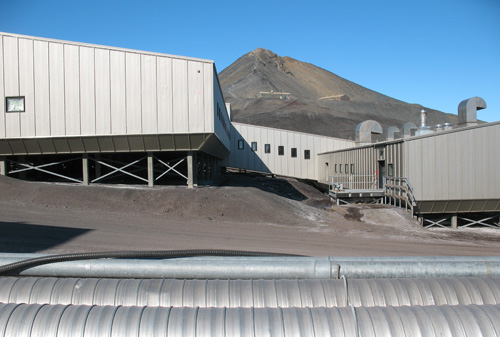 The building is named in honor of geophysicist and glaciologist Albert P. Crary (1911-1987), the first person to set foot on both the North and South Poles. The structure consists of five pods (sections designed to facilitate research in specific areas) built in three connected 'phases' numbered I through III from top to bottom. I and II are visible in the photo above.
The building is named in honor of geophysicist and glaciologist Albert P. Crary (1911-1987), the first person to set foot on both the North and South Poles. The structure consists of five pods (sections designed to facilitate research in specific areas) built in three connected 'phases' numbered I through III from top to bottom. I and II are visible in the photo above. 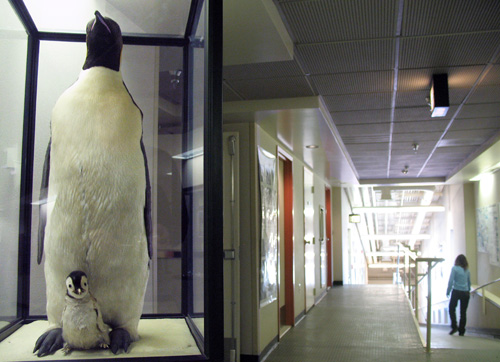 Crary has 46,000 square feet of working space for its labs, analytical instrumentation, and staging areas. It also supports special activities such as environmental monitoring, snow and ice mechanics, and meteorology. Phase I has a two-story core pod and a biology pod. There are environmental rooms, chemistry labs, ice and rock sectioning rooms, specialty microscope and water areas, and intriguing display cases near the main entrance.
Crary has 46,000 square feet of working space for its labs, analytical instrumentation, and staging areas. It also supports special activities such as environmental monitoring, snow and ice mechanics, and meteorology. Phase I has a two-story core pod and a biology pod. There are environmental rooms, chemistry labs, ice and rock sectioning rooms, specialty microscope and water areas, and intriguing display cases near the main entrance. 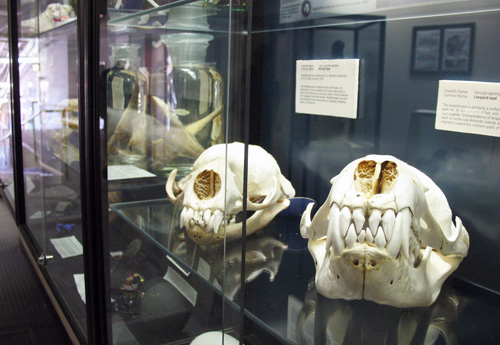 These cabinets of curiosities contain penguin eggs, meteorites retrieved from the continent, petrified wood from millions of years ago when Antarctica was part of Gondwanaland, preserved biological specimens in jars, and skulls of different types of seals. The one on the left is a Weddell seal pup, and the one on the right is a leopard seal.
These cabinets of curiosities contain penguin eggs, meteorites retrieved from the continent, petrified wood from millions of years ago when Antarctica was part of Gondwanaland, preserved biological specimens in jars, and skulls of different types of seals. The one on the left is a Weddell seal pup, and the one on the right is a leopard seal. 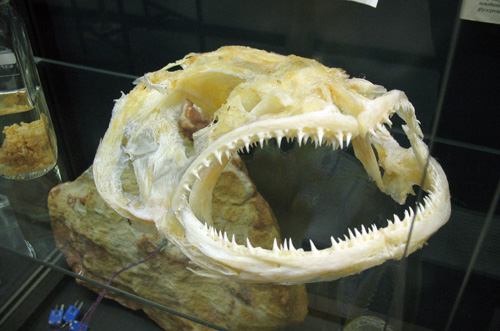 The signage tells us that this toothfish was collected in the summer of 1999-2000 in 450m of water adjacent to the ice runway in McMurdo Sound. It weighed approximately 85 lbs. and its thinness of bone results from having been cleaned in the water by amphipods.
The signage tells us that this toothfish was collected in the summer of 1999-2000 in 450m of water adjacent to the ice runway in McMurdo Sound. It weighed approximately 85 lbs. and its thinness of bone results from having been cleaned in the water by amphipods. 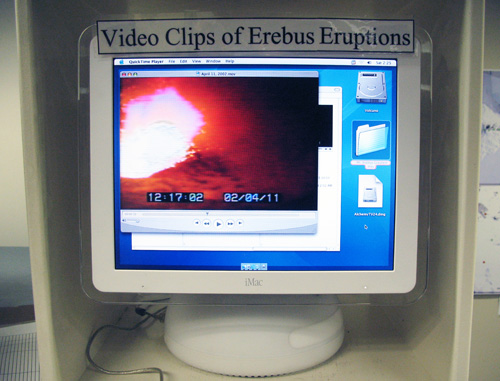 Phase II is home to earth sciences and atmospheric sciences. The collection of U.S. Geological Survey maps here from years past are a treat to behold. Another collection to get lost in are the Mt. Erebus eruption videos shot by a camera at the summit, peering down into the crater. The clips reside on a dedicated computer with a "greatest hits" folder for easy access to the fieriest spectacles. Many of these are from the second half of 2005, when this southernmost active volcano (right here on Ross Island!) experienced one of its liveliest seasons in 165 years.
Phase II is home to earth sciences and atmospheric sciences. The collection of U.S. Geological Survey maps here from years past are a treat to behold. Another collection to get lost in are the Mt. Erebus eruption videos shot by a camera at the summit, peering down into the crater. The clips reside on a dedicated computer with a "greatest hits" folder for easy access to the fieriest spectacles. Many of these are from the second half of 2005, when this southernmost active volcano (right here on Ross Island!) experienced one of its liveliest seasons in 165 years.  Having read the sign, I figured it safer to photograph the door than what's behind it. Good thing, because it turns out that a powerful green laser beam shoots upwards into space from Crary to monitor the size of the ozone hole.
Having read the sign, I figured it safer to photograph the door than what's behind it. Good thing, because it turns out that a powerful green laser beam shoots upwards into space from Crary to monitor the size of the ozone hole. 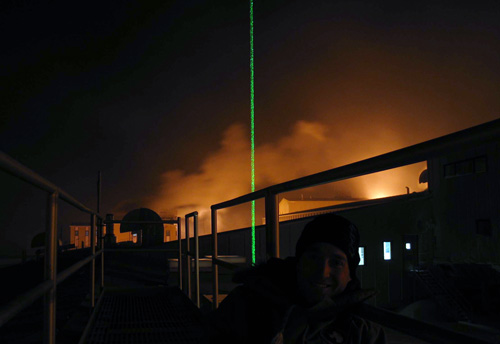 The best way to photograph the laser, it turns out, is from the outside in the dark of winter's precipitation when the beam is most visible. Here is Antarctic veteran Seth White's photo under just such circumstances. Thanks Seth, for sharing this very cool photo of the Light Detection And Ranging (LIDAR) system in action.
The best way to photograph the laser, it turns out, is from the outside in the dark of winter's precipitation when the beam is most visible. Here is Antarctic veteran Seth White's photo under just such circumstances. Thanks Seth, for sharing this very cool photo of the Light Detection And Ranging (LIDAR) system in action. 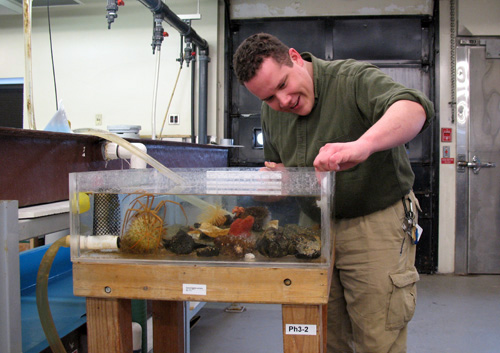 Phase III has an aquarium room with wet labs and running seawater. Here, Crary technician Rich Jenkins introduces me to the critters in the touch tank. The tank's rotating population includes nudibranches ("naked" snails without shells), anemones, giant sea spiders, isopods, crinoids, urchins, sponges and starfish.
Phase III has an aquarium room with wet labs and running seawater. Here, Crary technician Rich Jenkins introduces me to the critters in the touch tank. The tank's rotating population includes nudibranches ("naked" snails without shells), anemones, giant sea spiders, isopods, crinoids, urchins, sponges and starfish.  In a corner of the tank, a giant sea spider harasses an isopod. Although the small crustacean possesses an armored, spiny body, it falls prey even to fish.
In a corner of the tank, a giant sea spider harasses an isopod. Although the small crustacean possesses an armored, spiny body, it falls prey even to fish. 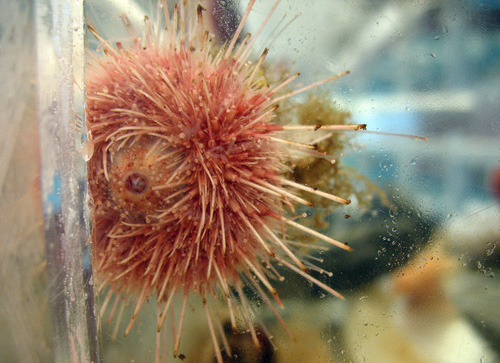 The sea urchin is less likely to be picked on.
The sea urchin is less likely to be picked on.  Behind me are Phase III's tanks in which live animals are held and equipment is tested before use in the field. By this time of the year though, the big tanks are emptying out as the diving season winds down. Next: New discoveries at Crary Lab.
Behind me are Phase III's tanks in which live animals are held and equipment is tested before use in the field. By this time of the year though, the big tanks are emptying out as the diving season winds down. Next: New discoveries at Crary Lab.
0
0